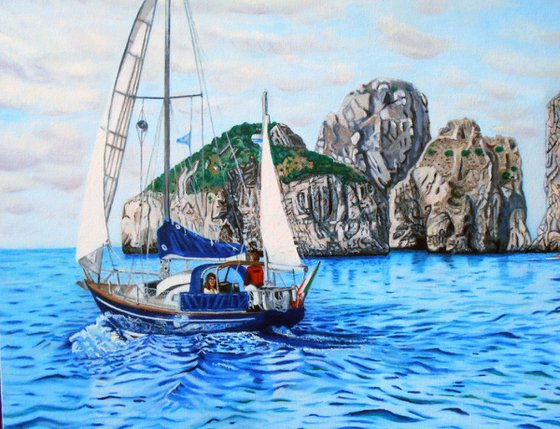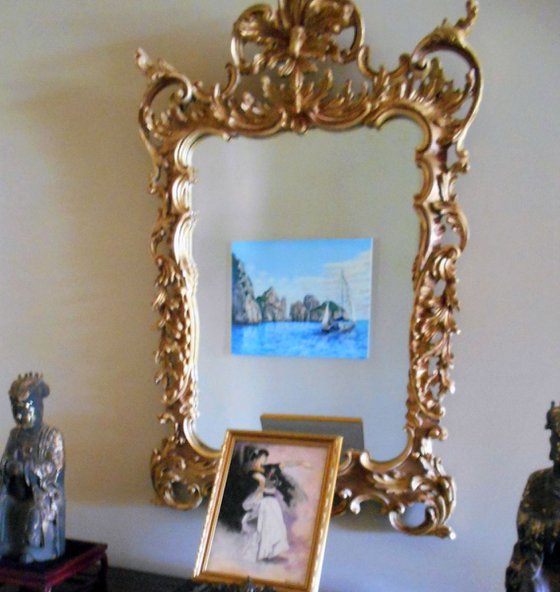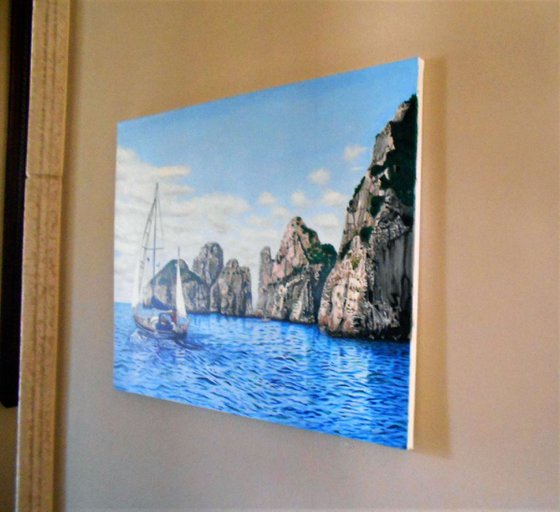- By medium
- By subject
- By budget
- Sales
- Gift cards
- Discover all art
- Artists
- Editors’ picks
- Ideas
Original artwork description:
Think Capri. One of the first images to come to mind will, no doubt, be that of the Faraglioni: the three spurs of rock which rise up out of the sea, within meters of the island's Southern coast. The rocks have each been given a name: the first, still attached to the land, is called Stella, the second, separated from the first block by a stretch of sea; Faraglione di Mezzo and the third, Faraglione di Fuori or Scopolo, meaning the head or promontory stretching into the sea.The Scopolo sea stack provides the unique habitat for the Podarcis sicula coerulea. The rock is, in fact, the only place in the world where you can find this lizard, the blue color of which is said to be the result of the amphibian's vicinity to the sea and sky. The average height of the Faraglioni is 100 meters. The Faraglione di Mezzo is characterized by a central cavity, large enough to allow for the passage of a small boat.
Materials used:
Oil
Tags:
#scopolo #faraglioni eocks #cloud cover #reflection on boat #ocean #cliffs #capri italy #saliboatCapri - Faraglioni Rocks (2015) Oil painting
by Jeffrey Allen Phillips - My JP Art
£2,575.35
- Oil painting on Canvas
- One of a kind artwork
- Size: 76.2 x 60.96 x 2.54cm (unframed) / 76.2 x 60.96cm (actual image size)
- Ready to hang
- Signed on the front
- Style: Photorealistic
- Subject: Landscapes, sea and sky
Loading
Original artwork description
Think Capri. One of the first images to come to mind will, no doubt, be that of the Faraglioni: the three spurs of rock which rise up out of the sea, within meters of the island's Southern coast. The rocks have each been given a name: the first, still attached to the land, is called Stella, the second, separated from the first block by a stretch of sea; Faraglione di Mezzo and the third, Faraglione di Fuori or Scopolo, meaning the head or promontory stretching into the sea.The Scopolo sea stack provides the unique habitat for the Podarcis sicula coerulea. The rock is, in fact, the only place in the world where you can find this lizard, the blue color of which is said to be the result of the amphibian's vicinity to the sea and sky. The average height of the Faraglioni is 100 meters. The Faraglione di Mezzo is characterized by a central cavity, large enough to allow for the passage of a small boat.
Materials used:
Oil
Tags:
#scopolo #faraglioni eocks #cloud cover #reflection on boat #ocean #cliffs #capri italy #saliboat14 day money back guaranteeLearn more




